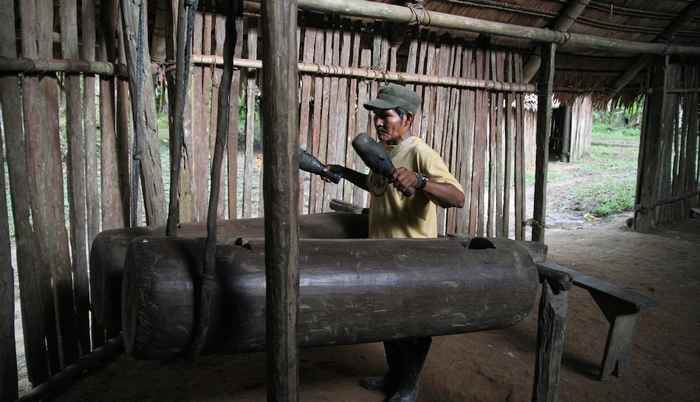Rhythm crucial in drummed speech
25 April 2018

The human voice can produce rich and varied acoustic signals to transmit information. Normally, this transmission only has a reach of about 200 metres. The Boras, an indigenous group of about 1,500 members residing in small communities in the Amazonian rainforest of Colombia and Peru, can extend this range by a factor of 100 by emulating Bora phrases in sequences of drumbeats. The Boras do this with manguaré drums – pairs of wooden slit drums carved from single logs (each about two metres), traditionally through burning. Each drum can produce two pitches, a pair four in total.

Public announcement
The Boras use manguaré drums in two ways. One is the ‘musical mode’, which is used to perform memorised drum sequences with little or no variation as part of rituals and festivals. The other is the ‘talking mode’, which is used to transmit relatively informal messages and public announcements. ‘For example, the manguaré is used to ask someone to bring something or to come do something, to announce the outcome of non-alcoholic drinking competitions or the arrival of visitors’, says Seifart. ‘In this mode, only two pitches are used and each beat corresponds to a syllable of a corresponding phrase of spoken Bora. The announcements contain on average 15 words and 60 drum beats.’
The respective sound files contain recordings of spoken and drummed Bora: káʔgúnúkòúβú ò áʔʦàkúnè (cáhgúnúcoúvú o áhtsacúne in simplified orthography), which translates as 'I am finishing the cahuana’ is used to announce that the drummer is the winner of a cahuana (non-alcoholic manioc starch drink) contest.
Rhythm essential
The Boras use drummed Bora to mimic the tone and rhythm of their spoken language and they elaborate Bora phrases in order to overcome remaining ambiguities. Seifart: ‘Rhythm turns out to be crucial for distinguishing words in drummed Bora. ‘There are four rhythmic units encoded in the length of pauses between beats. These units correspond to vowel-to-vowel intervals with different numbers of consonants and vowel lengths. The two phonological tones represented in drummed speech encode only a few lexical contrasts. Rhythm therefore appears to crucially contribute to the intelligibility of drummed Bora.’
This, the researchers argue, provides novel evidence for the role of rhythmic structures composed of vowel-to-vowel intervals in the complex puzzle concerning the redundancy and distinctiveness of acoustic features embedded in speech.
Publication details
Frank Seifart, Julien Meyer, Sven Grawunder & Laure Dentel: ‘Reducing language to rhythm: Amazonian Bora drummed language exploits speech rhythm for long-distance communication’, in: Royal Society Open Science, 25 April 2018. DOI: 10.1098/rsos.170354